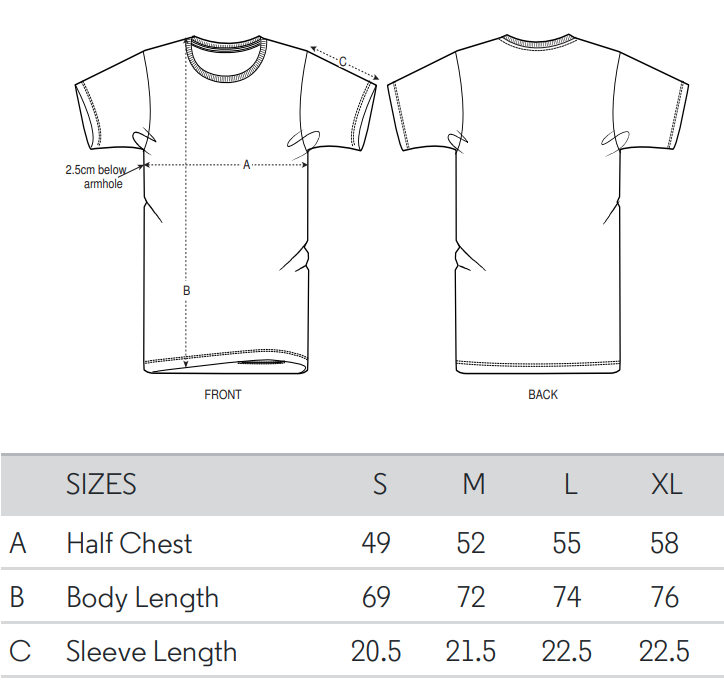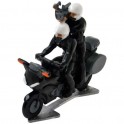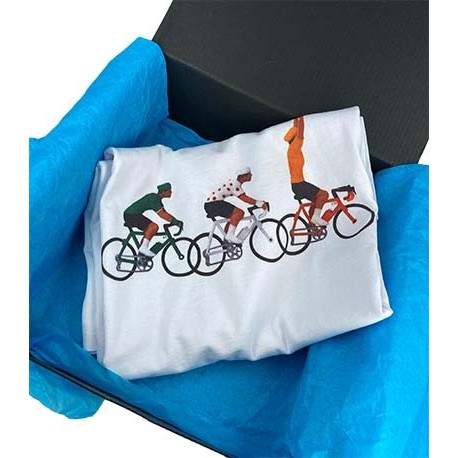No products
Set Tour de France 2 in gift box
New product
Cyclists:
Yellow jersey
Green jersey
Polka-dot jersey
T-shirt
with 3 riders' print: Polka-dot jersey /Green jersey and Yellow jersey. High quality material and print.
Developed in cooperation with designer DLP.
- Material: 100% organic cotton
- Grammage: 180 gr
- Neckline: Round neck
- Pattern: Print Polka-dot jersey /Green jersey and Yellow jersey
- Model: Casual fit

19 Items
- Remove this product from my favorite's list.
- Add this product to my list of favorites.
More info
WASHING INSTRUCTIONS
To prolong the life of our clothes, we recommend turning them inside out and washing them at 30 degrees. Furthermore, we strongly advise against ironing the print.
T-shirt Yellow jersey
The yellow jersey is the shirt in which the leader of the general classification of the Tour de France rides.
Henri Desgrange is the founder of the Tour de France. He always tried to make the race more attractive. At the same time, he wanted to generate more turnover for his newspaper l'Auto. An example to make the race more interesting was the introduction of a leader's jersey. This made it possible to recognise the leader of the general classification. The first yellow jersey was awarded during the Tour of 1919. The first one to wear the yellow jersey was Eugène Christophe. The first winner, who was allowed to put on the jersey in Paris, was Firmin Lambot. The yellow was chosen because l'Auto, the organizing newspaper, was printed on yellow paper. Getting a yellow jersey is a great honour for many riders, even if the General classification is not won.
After the introduction of the yellow jersey for the general classification, other jerseys were introduced. The polka dot jersey came for the leader in the mountain classification, the green jersey for the points classification, and the white jersey for the youth classification. Afterwards, other major stage races such as the Tour of Italy and the Tour of Spain also introduced a leader's jersey.
T-shirt Green jersey
In the Tour de France there is a points classification. This is a side classification in which the riders can earn points per stage, depending on their classification in that stage. This side classification was introduced in 1953. The leader of the points classification wears the green jersey. The green colour was chosen because the sponsor was a lawnmower manufacturer. However, in 1968 there was an exception. Then the jersey was red instead of green because of the sponsor that year.
In the Tour from 1905 till 1911 there was a different points system. Penalty points were handed out based on classification and time. Whoever had the least points, won. More points could be earned in flat stages than in time trials and mountain stages. In most editions there were also bonification seconds to be earned. Thanks to these extra seconds a sprinter could also take the yellow jersey in the first stages of the Tour.
The Dutchman Wout Wagtmans was the first rider to wear the green jersey in 1953.
The first winner was Swiss Fritz Schär. He had the green jersey on the podium in Paris. The record holder in the number of final wins in the points classification is Peter Sagan. He won the jersey 7 times. The German rider Erik Zabel won the green jersey 6 times. 4 times the winner of the green jersey was also the final winner of the yellow jersey. Once it was Bernard Hinault, and 3 times it was Eddy Merckx. The green jersey is generally for the most regular sprinter; not always to the fastest sprinter in the Tour. Thor Hushovd won the green jersey in 2005 without winning a single stage.
T-shirt Polka-dot jersey
The mountain classification in the tour de France is a side classification. The points for this can be earned at the passage on a mountain top. The rider who has collected the most points is the leader in the mountain classification and is allowed to wear the polka dot jersey. After the last stage, the final winner of the mountain classification is declared the King of the Mountains.
The climbs where points can be earned for the mountain classification are divided into 5 categories: Outside category (e.g. Alpe d'Huez or Mont Ventoux), first category, second category, third category and fourth category.
The polka dot jersey was introduced in 1975. In the years before, there was no jersey for the mountain king. The first rider to wear the polka dot jersey was Joop Zoetemelk. The first winner of the polka dot jersey was Lucien Van Impe. The record holder in the number of final wins of the polka dot jersey is Richard Virenque. He won 7 times (in 1994, 1995, 1996, 1997, 1999, 2003 and 2004). The Spaniard Federico Bahamontes and the Belgian Lucien Van Impe each won him 6 times.
Every year there is also a "roof" in the Tour. That's the highest peak in the round. A Trophy Henri Desgrange is awarded to the rider who reaches this top first. The trophy is named after the founder of the Tour de France. The highest peak is usually the col du Galibier or the col du Tourmalet. On the Galibier there is also a monument in honour of Desgrange.
Customers who bought this product also bought:
-

Motorbike...
Motorbike with driver and cameraman Motorbike...
32,98 €
-

Team car...
Our miniature cars Miniature vehicle out of...
47,85 €









